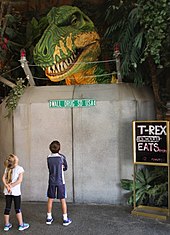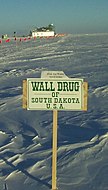
Wall Drug Store, often called simply Wall Drug, is a roadside attraction and tourist stop located in the town of Wall, South Dakota, adjacent to Badlands National Park. Wall Drug consists of a collection of cowboy-themed stores, including a drug store, gift shop, several restaurants, and various other stores, as well as an art gallery and an 80-foot (24 m) brontosaurus sculpture. Unlike a traditional shopping mall, all the stores at Wall Drug operate under a single entity rather than being run individually. The New York Times has described Wall Drug as "a sprawling tourist attraction of international renown draws some two million annual visitors to a remote town".
History
| This section needs additional citations for verification. Please help improve this article by adding citations to reliable sources in this section. Unsourced material may be challenged and removed. (July 2021) (Learn how and when to remove this message) |

The small-town drugstore made its first step towards fame when it was purchased by Ted Hustead in 1931. Hustead was a Nebraska native and pharmacist who was looking for a small town with a Catholic church in which to establish his business. He bought Wall Drug, located in a 231-person town in what he referred to as "the middle of nowhere," and strove to make a living. Business was very slow until his wife, Dorothy, thought of advertising free ice water to thirsty travelers heading to the newly opened Mount Rushmore monument 60 miles (97 km) to the west. From that time on, business was brisk.
Ted's son, Bill Hustead, also a pharmacist, returned to Wall and joined the family business in 1951. Under his direction, Wall Drug grew into a cowboy-themed mall and department store. In addition, he created the Art Gallery Cafe, with a design inspired by Club "21" in New York City, one of his favorite restaurants. In addition, Wall Drug includes a western art museum, a chapel based on the one found at New Melleray Abbey near Dubuque, Iowa, another Bill Hustead creation, and an 80-foot (24 m) brontosaurus that can be seen right off Interstate 90. It was designed by Emmet Sullivan, who also created the dinosaurs at Dinosaur Park in Rapid City and Dinosaur World in Arkansas.
Bill Hustead had seven children, and his oldest child, Rick Hustead, is the current proprietor of Wall Drug Store.
Marketing campaign
Wall Drug earns much of its fame from its self-promotion. Billboards advertising the establishment can be seen for hundreds of miles throughout South Dakota and the neighboring states. In addition, many visitors of Wall Drug have erected signs throughout the world announcing the miles to Wall Drug from famous locations. By 1981, Wall Drug was claiming it was giving away 20,000 cups of water per day during the peak tourist season, lasting from Memorial Day until Labor Day, and during the hottest days of the summer.
Most of Wall Drug's advertisement billboards can be found on an approximately 650-mile-long (1,050 km) stretch of Interstate 90 from Minnesota to Billings, Montana. The signs are created by South Dakota billboard artists, including Dobby Hansen and Barry Knutson of Philip.
Today

To date, Wall Drug still offers free ice water, but as they have become more popular, they have started to offer free bumper stickers to aid in promotion, and coffee for 5 cents. Some popular free bumper stickers read "Where the heck is Wall Drug?" and "Have You Dug Wall Drug?".
Wall Drug has over 300 original oil paintings in the Western Art Gallery Dining Rooms. This acquisition represents one of the country's best private collections of original Western and Illustration Art. Artists featured include N. C. Wyeth, Harvey Dunn, Dean Cornwell, Louis Glanzman, and Harold Von Schmidt.
When the United States Air Force was still operating Minuteman missile silos in the western South Dakota plains, Wall Drug used to offer free coffee and doughnuts to service personnel if they stopped in on their way to or from Ellsworth Air Force Base (50 miles (80 km) west on Interstate 90). To this day, Wall Drug continues to offer coffee and doughnuts which are free to active military personnel and also popular among ordinary tourists.
Ted and Bill Hustead died in 1999. The following day, South Dakota Governor Bill Janklow began his annual State of the State address by commemorating Hustead as "a guy that figured out that free ice water could turn you into a phenomenal success in the middle of a semi-arid desert way out in the middle of someplace".
Media references
- In 1981, Wall Drug was featured in Time magazine as one of the largest tourist attractions in the north
- In his 1989 book, The Lost Continent, Bill Bryson wrote, "It's an awful place, one of the world's worst tourist traps, but I loved it and I won't have a word said against it."
- The history of Wall Drug was told in a two-episode story arc of the podcast The Radio Adventures of Dr. Floyd
- In 2016, Z Nation featured Wall Drug in season 3, episode 8
- The 2020 drama film Nomadland features scenes where the main characters work at Wall Drug and visit the dinosaur statue
Gallery
-
 The Wall Drug Cowboy Orchestra
The Wall Drug Cowboy Orchestra
-
 A typical Wall Drug billboard
A typical Wall Drug billboard
-
 Sign in Afghanistan
Sign in Afghanistan
-
 Wall Drug sign in Antarctica – Free Ice Water, 9,333 miles
Wall Drug sign in Antarctica – Free Ice Water, 9,333 miles
-
 Wall Drug Jackalope, man for size reference
Wall Drug Jackalope, man for size reference
-
 The Wall, South Dakota Community Library
The Wall, South Dakota Community Library
Further reading
- Salena Zito (8 Aug 2021). "In South Dakota, the road signs lead to the Wall". Washington Examiner.
See also
- South of the Border, a similar attraction off Interstate 95 in South Carolina, just south of the border with North Carolina
- Badlands National Park
- Breezewood, Pennsylvania
- Uranus, Missouri
References
- ^ Thomas, Robert McG. Jr. (January 17, 1999). "Ted Hustead Is Dead at 96; Built the Popular Wall Drug". The New York Times.
- Kirouac, Matt. "The Quirky History of South Dakota's Wall Drug Store". The Culture Trip. The Culture Trip Ltd. Retrieved 10 December 2020.
- Murtaugh, Taysha (2017-05-25). "Why This Small Town of 882 People Attracts 22,000 Visitors a Day". Country Living. Retrieved 2020-12-10.
- "In South Dakota: Buffalo Burgers at Wall Drug". Time. August 13, 1981. Archived from the original on March 14, 2008.
- Bryson, Bill. The Lost Continent: Travels in Small-Town America (2011 ed.). Random House Digital. p. 199. ISBN 978-0-385-67456-0. Excerpts available at Google Books.
External links
43°59′36″N 102°14′30″W / 43.993231°N 102.241795°W / 43.993231; -102.241795
Categories:- Roadside attractions in South Dakota
- Buildings and structures in Pennington County, South Dakota
- Pharmacies of the United States
- Landmarks in South Dakota
- Restaurants in South Dakota
- American companies established in 1931
- Retail companies established in 1931
- 1931 establishments in South Dakota
- Tourist attractions in Pennington County, South Dakota
- Health care companies based in South Dakota
- South Dakota culture